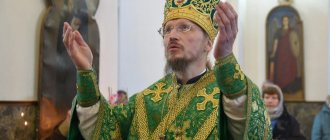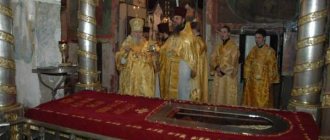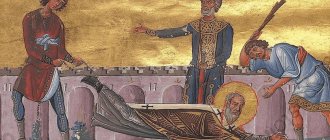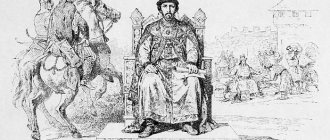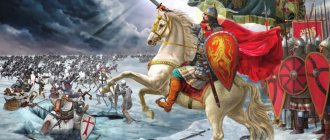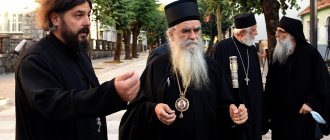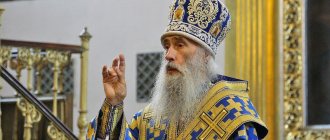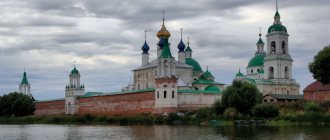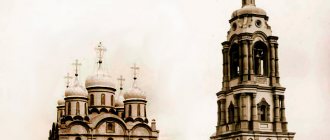Metropolitan Peter Polyansky Peter Fedorovich
Bishop of the Russian Orthodox Church. Metropolitan of Krutitsky. Glorified as the New Martyrs and Confessors of Russia by the Council of Bishops.
Pyotr Polyansky was born on July 10, 1862 in the village of Storozhevoye, Voronezh region. He grew up in the family of a parish priest. He studied at the Kostroma Theological School. In 1885, after graduating from the Voronezh Theological Seminary in the first category, he was appointed to the position of psalm-reader at the church of the village of the Maidens in Korotoyaksky district. In 1887 he became a volunteer, and after passing the exams - a student at the Moscow Theological Academy. During his student years, he was distinguished by his complacency, complaisance, and goodwill.
In 1892, Polyansky graduated from the academy with a candidate of theology degree, received for his work “On the Pastoral Epistles.” In the same year, he became an assistant inspector of the Moscow Theological Academy, and also taught the Law of God free of charge at a private women's school in Sergiev Posad and was the secretary of the Water Rescue Society.
In 1895, Peter Polyansky was the church warden of the Epiphany Church in his native village of Storozhevoy. He was awarded archpastoral gratitude for his special diligence in beautifying the church. In 1896, for a short time he taught Greek at the Zvenigorod Theological School. Then he was appointed caretaker of the Zhirovitsky Theological School. In 1897 he was awarded the title of Master of Theology for his dissertation: “The First Epistle of St. Apostle Paul to Timothy. Experience of historical and exegetical research."
Pyotr Fedorovich served as a member-competitor of the guardianship of people's sobriety, an honorary magistrate judge of the Slonim district. He was awarded the Order of St. Stanislaus, III degree, on May 6, 1896, and on May 14, for special work, diligence and zeal for the improvement of local parochial schools and literacy schools, he was awarded the Bible by the Holy Synod.
In December 1901, Polyansky was appointed a member of the school council. For his zeal and work on church and school affairs, in 1902 he received an archpastoral blessing “with the issuance of a certificate of merit and inclusion in the service list.” In 1906, he was transferred to serve in St. Petersburg as a junior assistant to the director of affairs of the Educational Committee at the Holy Synod. Subsequently, he became a member of the Educational Committee, performing mainly the duties of an auditor of religious educational institutions.
During his service in the Educational Committee, Pyotr Fedorovich Polyansky examined the state of theological seminaries, diocesan women's schools in Kursk, Novgorod, Vologda, Kostroma, Minsk and a number of other dioceses, visited Siberia, the Urals, and Transcaucasia. After each such visit, a detailed report was drawn up, which suggested appropriate measures to improve the condition of the examined school.
In 1916, Polyansky was awarded the rank of actual state councilor, which gave hereditary nobility and corresponded to the ranks of major general in the army, rear admiral in the navy and the court rank of chamberlain. In the same year, for outstanding success in the field of church administrative and pedagogical service, he was awarded the Order of St. Vladimir. In 1918, after the closure of the Educational Committee, he moved to Moscow, where he took part in the work of the Local Council, being a member of its secretariat.
Left without work, Pyotr Polyansky got a job as chief accountant in the Bogatyr cooperative artel. He lived in Moscow, in the house of his brother, Archpriest Vasily Polyansky, cleric of the Church of St. Nicholas on the Pillars. Since 1919 he was the head of the shelter.
At the beginning of 1920, Polyansky took monastic vows with the name Peter. Within a year, he was ordained to the rank of hierodeacon, hieromonk and archimandrite, and also became rector of the Moscow Chrysostom Monastery. In October, in the Sergievsky Church of the Trinity Metochion in Moscow, he was consecrated Bishop of Podolsk, vicar of the Moscow diocese.
Bishop Peter was arrested on February 22, 1921 and imprisoned in Tagansk prison. In April of the same year, he was sentenced to two months in prison with credit for pre-trial detention. In August he was arrested for the second time. Exiled to the city of Veliky Ustyug. There, at first he lived with a priest he knew, then in the gatehouse at the city cathedral. In exile, he had the opportunity to celebrate the Divine Liturgy with the concelebration of the Veliky Ustyug clergy. In exile I found a company to confiscate church valuables, the arrest of the Patriarch, and the seizure of church power by renovationists.
In August 1923, Bishop Peter returned to Moscow and became the closest adviser and assistant to Patriarch Tikhon. Appointed on October 14 as a member of the Provisional Patriarchal Holy Synod with elevation to the rank of archbishop. In November, he took over the post of manager of the Epiphany Monastery in Moscow. In January he was appointed Archbishop of Krutitsky, governing the Moscow diocese. In March he was elevated to metropolitan dignity.
After the death of Patriarch Tikhon on April 7, 1925, Metropolitan Peter assumed locum tenens duties. On the day of the patriarch’s burial, a meeting of the assembled archpastors took place, at which it was decided to assign the duties of the patriarchal locum tenens to Metropolitan Peter of Krutitsky.
The Metropolitan, as a locum tenens, helped many prisoners and exiles. Receiving donated money after the service, he usually immediately gave it away to be sent to prisons, camps and places of exile. He gave the blessing to parish clergy to donate to the benefit of imprisoned clergy. He often celebrated the Divine Liturgy in Moscow parish and monastery churches, including the St. Daniel Monastery.
Peter resolutely opposed any agreements with the renovationists. Representatives of renovationism accused the metropolitan of having relations with church and political emigration, of counter-revolutionary sentiments and anti-government activities. He also refused to agree to the conditions of the punitive authorities, under which they promised to normalize the legal position of the Church. By decision of the Commission for the implementation of the Decree on the separation of Church and state, on December 9, Metropolitan Peter was arrested. During the investigation, he was kept in the internal prison on Lubyanka, as well as in the Suzdal political detention center. In November 1926 he was sentenced to three years of exile. In December he was transported through transit prisons to Tobolsk, and in February 1927 he was taken to the village of Abalak, where he was kept in the Abalak monastery.
At the beginning of April, Metropolitan Peter was again arrested and taken to Tobolsk prison. In the summer, by order of the All-Russian Central Executive Committee, he was sent beyond the Arctic Circle to the village of He. Later, on May 11, 1928, by a resolution of the Special Meeting of the OGPU, the period of exile was extended by two years. Arrested again on August 17, 1930. He was held in prisons in Tobolsk and Yekaterinburg. He refused to relinquish the title of Patriarchal Locum Tenens, despite threats to extend his prison sentence.
In November, a criminal case was opened against the Metropolitan on charges that, while in exile, he “conducted defeatist agitation among the surrounding population, talking about the imminent war and the fall of the Sov. power and the need to fight the latter, and also tried to use the Church to stage a fight against the Owls. power." He pleaded not guilty. He was in solitary confinement without the right of transfer or visits. In 1931, he rejected the offer of security officer Yevgeny Tuchkov to sign a contract to cooperate with the authorities as an informant.
After a conversation with Tuchkov, Metropolitan Peter found himself partially paralyzed and also suffering from scurvy and asthma. At a special meeting of the OGPU on July 23, 1931, he was sentenced to five years in a camp, but was left in prison in an internal detention center. In July 1933, he was prohibited from walking in the common yard and was replaced by walks in a small damp courtyard. Despite this, he continued to refuse to resign.
Later, Metropolitan Peter was transferred to the Verkhneuralsk political isolation ward. In July 1936, his imprisonment was once again extended for three years. At the end of 1936, the Patriarchate received false information about the death of the Patriarchal Locum Tenens, which allegedly occurred on September 29, as a result of which on December 27, Metropolitan Sergius assumed the title of Patriarchal Locum Tenens. A memorial service was celebrated for the metropolitan.
In August 1937, the Patriarchal Locum Tenens was overtaken by the “Great Terror”; the authorities of the Verkhneuralsk political detention center began to accelerate the fabrication of execution cases. On October 2, the NKVD troika in the Chelyabinsk region sentenced him to death.
Metropolitan Peter October 10, 1937 . The burial place remains unknown.
At the Council of Bishops, held in February 1997, a decision was made to canonize the Locum Tenens of the Patriarchal Throne, Metropolitan Peter.
Memory of Metropolitan Peter
Memory of Metropolitan Peter
The church in the name of the Hieromartyr Peter, Metropolitan of Krutitsky (Bishops' Compound) on the Moscow Highway in Yekaterinburg was consecrated in 1999.
In 2003, in the city of Magnitogorsk, Chelyabinsk region, a cross was erected in the alley to the Holy Ascension Cathedral in memory of Metropolitan Peter. In 2013, the diocesan spiritual and educational center at the cathedral was named after the Holy Martyr Peter, Metropolitan of Krutitsky.
In the homeland of Metropolitan Peter in the village of Storozhevoy-1, construction of a church in honor of the Hieromartyr Peter (Polyansky) was completed in 2012.
Metropolitan Peter was elected heavenly patron of the Magnitogorsk diocese created on July 26, 2012.
The portrait of Metropolitan Peter is in the gallery of graduates of the Kostroma Theological Seminary, and his image is depicted on the icon “Cathedral of the Patron Saints of the Kostroma Theological Seminary”
04.06.2019
Veneration in Orthodoxy
Metropolitan Peter led the church in difficult years for Orthodoxy, when the state took the path of eradicating religion. The saint devoted all his strength to overcoming the schism, tried to defend the integrity of Orthodoxy, and defended priests and laity.
The Hieromartyr is glorified for his steadfastness of faith, fearlessness in the face of tormentors, and readiness to fight to the end for the ideals of Orthodoxy. The saint accomplished a feat - he became a priest, anticipating his death and knowing what a difficult path he would have to go through.
Orthodox texts
The Church glorifies the Hieromartyr Peter on September 27 in all Orthodox churches.
Troparion
Called by God's providence to holy service by the holy Patriarch Tikhon, you became a vigilant guardian and fearless defender for the flock of Christ, Hieromartyr Peter. You endured cruel imprisonments and distant exiles, suffering and death from the atheists. Having received the crown of martyrdom, you are now rejoicing in Heaven. Pray to the merciful God that he will preserve our Church from disorder, grant unanimity and peace to His people and save our souls.
Kontakion
Having acquired a peaceful and meek spirit, having a firm hope in God’s mercy, you have become a faithful guardian of the Russian Church and a confessor of Christ, Hieromartyr Peter, a constant representative for us before God and a prayer book for our souls.
Kontakion to the Moscow Saints
Live piously in the saints, and guide people to the understanding of God, and please God well; For this reason, from Him you are glorified by incorruptibility and miracles, as disciples of God’s grace.
You lived piously as saints and guided people to the knowledge of God and served God well, therefore you were glorified by Him for incorruptibility and miracles, taught by God’s grace
The birth of Peter and the beginning of his studies
Once in Volyn (now the northwestern part of Ukraine), in a noble boyar family, the mother of the future saint, shortly before his birth, saw in a dream that she was holding a lamb in her arms. Between its horns grows a wonderful tree with fruits and flowers, as well as burning candles. Soon, around 1260, she had a son - this was the future Metropolitan Peter.
When the boy was seven years old, they began to teach him to read and write and the Holy Scriptures, but this did not bring the expected result. He was unable to master anything until one day in a dream someone in holy robes touched Peter’s lips. It was from this moment that the future Metropolitan Peter began to study well.
Soon he managed to become the best of all the students and study all the Holy Scriptures.
The Righteous Path
At the age of twelve, the future Saint Peter (Metropolitan of Moscow) became a novice in a nearby monastery. In addition to doing all kinds of work, which he always did with humility, Peter was the first to come to church services.
He stood throughout the liturgy, listening to the Divine Scripture and praying with attention and humility, and never even once leaned his back against the wall the entire time. Seeing Peter's efforts in obedience, looking at his humility, the abbot of the monastery promoted the saint to a deacon, and later to a presbyter.
In addition, the saint became an icon painter, moving away from everything earthly during the moments of work on the image, imbued with the thought of God and striving with all his soul for a virtuous life. The future Metropolitan Peter of Moscow and All Rus' spent a very long time in the monastery.
Then he was blessed by the abbot and left the walls of the refuge in order to set up a monastery for himself on a river called Rati in a deserted place. The saint built there the Church of the Savior Jesus Christ, and then next to it - a monastery called Transfiguration.
Peter taught the brethren gathered there with meekness, considering himself the least of all. He was kind and never let beggars and strangers go without alms or help. Even the prince heard about him, because he was revered by everyone, and everyone joyfully accepted the holy instructions.
Metropolitan Peter
Metropolitan Maxim, who arrived from Constantinople, was teaching the people in Rus' at that time. Peter presented him with an icon of the Most Holy Theotokos of his own making (called Petrovskaya), and also asked himself and the brethren for blessings. Having given it, the Metropolitan respectfully accepted the image and kept it with him.
Subsequently, the icon was located in the Assumption Cathedral of the Kremlin in Moscow. The hour of the death of Metropolitan Maxim has come. After this, they began to look for a candidate for his most holy post.
There were two candidates: Yuri Lvovich, Prince of Galicia-Volyn, persuaded Peter to go to become a metropolitan, and the Prince of Tver and Vladimir proposed the Tver abbot Gerontius for the post of saint. The second candidate went by sea to Constantinople, but a storm overtook him on the way.
Then the Most Holy Theotokos told Gerontius in a vision that Peter should be the metropolitan. The destiny of Peter was also revealed to Patriarch Athanasius of Constantinople. When the saint entered the temple, a fragrance filled everything around. This was a sign for the patriarch, who joyfully blessed Peter.
But, as expected, there was a meeting of saints that considered the candidacy for the post of metropolitan. It recognized that Peter was worthy of this post, which was destined for him long before birth. During the dedication, all those present understood that he was God’s chosen one, who had come here at the behest of the Heavenly Father, as his face lit up.
Intrigues against Peter
The newly-consecrated Saint Peter, Metropolitan of Moscow, received instructions from the Patriarch for several days after his consecration, and then left Constantinople to begin his duties.
But meek and gentle when it came to himself, and firm and strict in church matters, he caused discontent on the part of some people. Among them was the envious Bishop of Tver Andrei.
He slandered the saint, wrote to His Holiness Patriarch Athanasius such accusations against the Metropolitan that he did not even believe them, but still sent the church cleric out. The Russian Church convened a council in Pereyaslavl.
The investigation exposed false evidence against Peter, and the instigator was put to shame. The saint did not harbor any grudge against Bishop Andrei and, having forgiven him, dismissed the council. By this, Metropolitan Peter gained even greater respect and veneration.
Acts of the Saint
Peter traveled all over Rus' for the benefit of the people. In the Golden Horde he achieved benefits for the clergy. The Metropolitan tried with all his might to pacify the warring princes. Their quarrels worried Peter most of all. Arriving in Bryansk in order to smooth out another conflict, the Metropolitan almost became a victim of murder.
Understanding and foreseeing that the unification of Rus' was possible through Moscow, Peter often visited this then small and unimportant town. At that time, Georgy Danilovich was the prince there, but he was often not in the city. In his absence, Prince John's brother was a very kind ruler. He always helped the poor and disadvantaged.
It was with John that Peter often talked about the affairs of the church and the future of the city of Moscow. The Metropolitan predicted greatness and prosperity for the prince's family. Saint Peter wanted to move his see specifically to Moscow, for which a cathedral was needed.
The Russian Church owes the construction of the Assumption Cathedral in the Moscow Kremlin to St. Peter, according to whose thoughts it was founded in 1326. At the base of the structure, near the altar, Metropolitan Peter of Moscow placed his coffin.
Prediction of the death of a saint
After some time, Prince John saw in a dream a very high mountain covered in snow. The snow melted, and after it the mountain disappeared. Saint Peter explained what this means. The melted snow is the death of the metropolitan, and the missing mountain is the death of the prince. Peter himself received a revelation about his own death, but no one knows which one.
